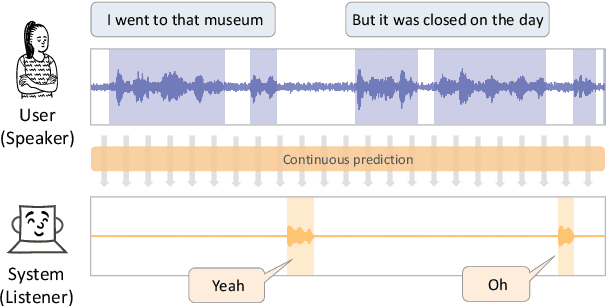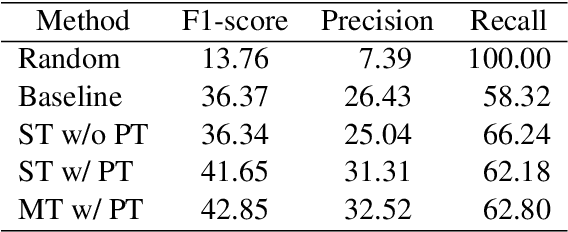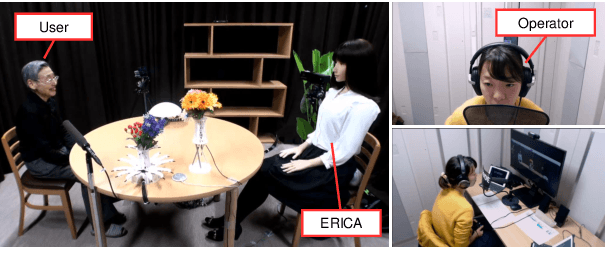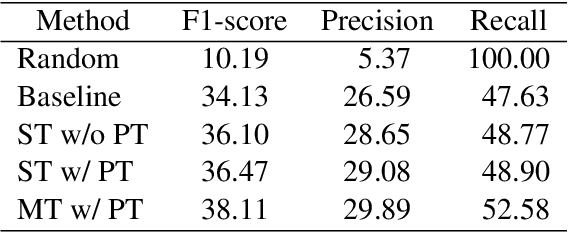Divesh Lala
Does the Appearance of Autonomous Conversational Robots Affect User Spoken Behaviors in Real-World Conference Interactions?
Mar 17, 2025Abstract:We investigate the impact of robot appearance on users' spoken behavior during real-world interactions by comparing a human-like android, ERICA, with a less anthropomorphic humanoid, TELECO. Analyzing data from 42 participants at SIGDIAL 2024, we extracted linguistic features such as disfluencies and syntactic complexity from conversation transcripts. The results showed moderate effect sizes, suggesting that participants produced fewer disfluencies and employed more complex syntax when interacting with ERICA. Further analysis involving training classification models like Na\"ive Bayes, which achieved an F1-score of 71.60\%, and conducting feature importance analysis, highlighted the significant role of disfluencies and syntactic complexity in interactions with robots of varying human-like appearances. Discussing these findings within the frameworks of cognitive load and Communication Accommodation Theory, we conclude that designing robots to elicit more structured and fluent user speech can enhance their communicative alignment with humans.
An LLM Benchmark for Addressee Recognition in Multi-modal Multi-party Dialogue
Jan 28, 2025Abstract:Handling multi-party dialogues represents a significant step for advancing spoken dialogue systems, necessitating the development of tasks specific to multi-party interactions. To address this challenge, we are constructing a multi-modal multi-party dialogue corpus of triadic (three-participant) discussions. This paper focuses on the task of addressee recognition, identifying who is being addressed to take the next turn, a critical component unique to multi-party dialogue systems. A subset of the corpus was annotated with addressee information, revealing that explicit addressees are indicated in approximately 20% of conversational turns. To evaluate the task's complexity, we benchmarked the performance of a large language model (GPT-4o) on addressee recognition. The results showed that GPT-4o achieved an accuracy only marginally above chance, underscoring the challenges of addressee recognition in multi-party dialogue. These findings highlight the need for further research to enhance the capabilities of large language models in understanding and navigating the intricacies of multi-party conversational dynamics.
Why Do We Laugh? Annotation and Taxonomy Generation for Laughable Contexts in Spontaneous Text Conversation
Jan 28, 2025Abstract:Laughter serves as a multifaceted communicative signal in human interaction, yet its identification within dialogue presents a significant challenge for conversational AI systems. This study addresses this challenge by annotating laughable contexts in Japanese spontaneous text conversation data and developing a taxonomy to classify the underlying reasons for such contexts. Initially, multiple annotators manually labeled laughable contexts using a binary decision (laughable or non-laughable). Subsequently, an LLM was used to generate explanations for the binary annotations of laughable contexts, which were then categorized into a taxonomy comprising ten categories, including "Empathy and Affinity" and "Humor and Surprise," highlighting the diverse range of laughter-inducing scenarios. The study also evaluated GPT-4's performance in recognizing the majority labels of laughable contexts, achieving an F1 score of 43.14%. These findings contribute to the advancement of conversational AI by establishing a foundation for more nuanced recognition and generation of laughter, ultimately fostering more natural and engaging human-AI interactions.
Human-Like Embodied AI Interviewer: Employing Android ERICA in Real International Conference
Dec 13, 2024Abstract:This paper introduces the human-like embodied AI interviewer which integrates android robots equipped with advanced conversational capabilities, including attentive listening, conversational repairs, and user fluency adaptation. Moreover, it can analyze and present results post-interview. We conducted a real-world case study at SIGDIAL 2024 with 42 participants, of whom 69% reported positive experiences. This study demonstrated the system's effectiveness in conducting interviews just like a human and marked the first employment of such a system at an international conference. The demonstration video is available at https://youtu.be/jCuw9g99KuE.
Yeah, Un, Oh: Continuous and Real-time Backchannel Prediction with Fine-tuning of Voice Activity Projection
Oct 21, 2024



Abstract:In human conversations, short backchannel utterances such as "yeah" and "oh" play a crucial role in facilitating smooth and engaging dialogue. These backchannels signal attentiveness and understanding without interrupting the speaker, making their accurate prediction essential for creating more natural conversational agents. This paper proposes a novel method for real-time, continuous backchannel prediction using a fine-tuned Voice Activity Projection (VAP) model. While existing approaches have relied on turn-based or artificially balanced datasets, our approach predicts both the timing and type of backchannels in a continuous and frame-wise manner on unbalanced, real-world datasets. We first pre-train the VAP model on a general dialogue corpus to capture conversational dynamics and then fine-tune it on a specialized dataset focused on backchannel behavior. Experimental results demonstrate that our model outperforms baseline methods in both timing and type prediction tasks, achieving robust performance in real-time environments. This research offers a promising step toward more responsive and human-like dialogue systems, with implications for interactive spoken dialogue applications such as virtual assistants and robots.
Analysis and Detection of Differences in Spoken User Behaviors between Autonomous and Wizard-of-Oz Systems
Oct 04, 2024Abstract:This study examined users' behavioral differences in a large corpus of Japanese human-robot interactions, comparing interactions between a tele-operated robot and an autonomous dialogue system. We analyzed user spoken behaviors in both attentive listening and job interview dialogue scenarios. Results revealed significant differences in metrics such as speech length, speaking rate, fillers, backchannels, disfluencies, and laughter between operator-controlled and autonomous conditions. Furthermore, we developed predictive models to distinguish between operator and autonomous system conditions. Our models demonstrated higher accuracy and precision compared to the baseline model, with several models also achieving a higher F1 score than the baseline.
Evaluation of a semi-autonomous attentive listening system with takeover prompting
Feb 21, 2024Abstract:The handling of communication breakdowns and loss of engagement is an important aspect of spoken dialogue systems, particularly for chatting systems such as attentive listening, where the user is mostly speaking. We presume that a human is best equipped to handle this task and rescue the flow of conversation. To this end, we propose a semi-autonomous system, where a remote operator can take control of an autonomous attentive listening system in real-time. In order to make human intervention easy and consistent, we introduce automatic detection of low interest and engagement to provide explicit takeover prompts to the remote operator. We implement this semi-autonomous system which detects takeover points for the operator and compare it to fully tele-operated and fully autonomous attentive listening systems. We find that the semi-autonomous system is generally perceived more positively than the autonomous system. The results suggest that identifying points of conversation when the user starts to lose interest may help us improve a fully autonomous dialogue system.
Acknowledgment of Emotional States: Generating Validating Responses for Empathetic Dialogue
Feb 20, 2024Abstract:In the realm of human-AI dialogue, the facilitation of empathetic responses is important. Validation is one of the key communication techniques in psychology, which entails recognizing, understanding, and acknowledging others' emotional states, thoughts, and actions. This study introduces the first framework designed to engender empathetic dialogue with validating responses. Our approach incorporates a tripartite module system: 1) validation timing detection, 2) users' emotional state identification, and 3) validating response generation. Utilizing Japanese EmpatheticDialogues dataset - a textual-based dialogue dataset consisting of 8 emotional categories from Plutchik's wheel of emotions - the Task Adaptive Pre-Training (TAPT) BERT-based model outperforms both random baseline and the ChatGPT performance, in term of F1-score, in all modules. Further validation of our model's efficacy is confirmed in its application to the TUT Emotional Storytelling Corpus (TESC), a speech-based dialogue dataset, by surpassing both random baseline and the ChatGPT. This consistent performance across both textual and speech-based dialogues underscores the effectiveness of our framework in fostering empathetic human-AI communication.
An Analysis of User Behaviors for Objectively Evaluating Spoken Dialogue Systems
Jan 23, 2024Abstract:Establishing evaluation schemes for spoken dialogue systems is important, but it can also be challenging. While subjective evaluations are commonly used in user experiments, objective evaluations are necessary for research comparison and reproducibility. To address this issue, we propose a framework for indirectly but objectively evaluating systems based on users' behaviors. In this paper, to this end, we investigate the relationship between user behaviors and subjective evaluation scores in social dialogue tasks: attentive listening, job interview, and first-meeting conversation. The results reveal that in dialogue tasks where user utterances are primary, such as attentive listening and job interview, indicators like the number of utterances and words play a significant role in evaluation. Observing disfluency also can indicate the effectiveness of formal tasks, such as job interview. On the other hand, in dialogue tasks with high interactivity, such as first-meeting conversation, behaviors related to turn-taking, like average switch pause length, become more important. These findings suggest that selecting appropriate user behaviors can provide valuable insights for objective evaluation in each social dialogue task.
Towards Objective Evaluation of Socially-Situated Conversational Robots: Assessing Human-Likeness through Multimodal User Behaviors
Aug 21, 2023Abstract:This paper tackles the challenging task of evaluating socially situated conversational robots and presents a novel objective evaluation approach that relies on multimodal user behaviors. In this study, our main focus is on assessing the human-likeness of the robot as the primary evaluation metric. While previous research often relied on subjective evaluations from users, our approach aims to evaluate the robot's human-likeness based on observable user behaviors indirectly, thus enhancing objectivity and reproducibility. To begin, we created an annotated dataset of human-likeness scores, utilizing user behaviors found in an attentive listening dialogue corpus. We then conducted an analysis to determine the correlation between multimodal user behaviors and human-likeness scores, demonstrating the feasibility of our proposed behavior-based evaluation method.
 Add to Chrome
Add to Chrome Add to Firefox
Add to Firefox Add to Edge
Add to Edge